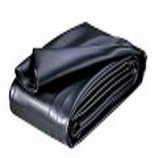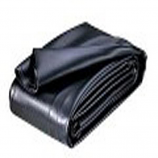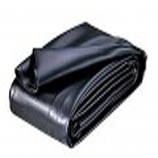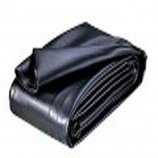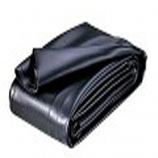How to Select a Pond Filter
Also see "How to choose your pond pump"
- Introduction to pond filters
- Type of filters
- Filter Selection
- Small & Shallow Ponds (up to 950 litres approx.)
- Plain Water Filtration - No Waterfall or Stream
- Filters for Water Falls & Streams
- Using an In-Pond Filter
- Using an out of pond filter
- Pressurised Filter systems
- Gravity Discharge Filters
- Formulas for determining pump & filter size
- Actual Pond Volume
- Effective Pond Volume - Taking into account pond depth, sunshine & climate
- "Total Head" - maximum pumping height - Taking into account hose length and diameter
- Allowance for Fish Stocking Level
- Elbows - The effect they have on flow
- Power consumption
- Hose Flow rates
Introduction to pond filters
Maintaining a healthy pond environment with crystal clear water usually requires a filtration system. Filtration systems perform one or several of the following functions:
- Mechanical Filtration - traps debris in a material of some type for later removal during cleaning
- Biological Filtration - provides an environment where beneficial bacteria efficiently feed on impurities in the water breaking down fish wastes and other organic matter
- Ultra-Violet Clarification - causes single-cell algae (waterborne algae) to clump together under the action of ultra-violet light, greatly increasing the efficiency of filtration.
Most filters for mid-size and large ponds employ a combination of mechanical filtration and biological filtration, with ultra-violet clarification specified for particular pond types.
Depending on brand and model, mechanical filters can consist of layers of foam pads, trays of gravel, foam cartridges, or brushes. Some models combine several of these filtration media into one filter. In addition, many filters have a chamber containing plastic bio-media. These are specially designed plastic pieces 25 to 50 mm in diameter. Ten cubic centimetres of these pieces can contain as much as 1 square metre of surface area. This large surface area encourages the growth of beneficial bacteria colonies - the secret of effective bio-filtration. Once the colony is established, it converts ammonia from fish waste, dead organic matter and other impurities into nitrites and later into harmless nitrates which help promote the growth of plants.
Without help, it can take up to seven weeks for a bacteria colony to take up residence and grow large enough to be effective in a typical bio-filter. This process can be accelerated through the introduction of 'seed' bacteria, available either in dry, granular or liquid form.
The rate of water flow through the bio-filter will have a major effect on its effectiveness. All filters have a maximum flow rate which must not be exceeded. Slower flow rates may result in the volume of the pond not passing through the filter as often as required for efficient filtration. Excessive flow will not allow the bacteria sufficient time to clean the water and may dislodge the bacteria from the bio-media.
Care must also be take when cleaning a bio-filter. Mechanical elements (filter foam) should be gently rinsed in a separate container of pond water. If the filter contains more than one layer of filter foam, clean each in rotation. The bio-media should be disturbed as little as possible so that beneficial bacteria are not disturbed.
Types of Filters
There are a number of different filter designs.
In-Pond Filters:
These small filters, referred to as pre-filters, fit on the intake of the pump or around the pump itself and allow the pump's discharge to supply a fountain head or waterfall if desired. They are usually only used in smaller ponds and tend to be more difficult to maintain as they must be removed from the pond for cleaning. An in-pond pre-filter is not to be confused with a removable pump pre-filter. Removable pump pre-filters are usually small foam filters designed to protect the pump from large particles that may damage its impellor. Pump pre-filters whilst not designed to filter the pond water do have some minimal effect in reducing the amount of suspended solids in the water .
Out-of-pond Filters:
There are two main types of out-of-pond (above-ground) filters, 'pressurised' and 'gravity-discharge'. These type filters have the advantage of being readily accessible for routine maintenance as they are not immersed in the pond.
Pressure filters
Pressure filters such as the Oase FiltoClear, Cyclone or Hozelock Bioforce range allow you to filter the water and discharge it under pressure to the top of a waterfall. The amount of lift that can be achieved after the filter discharge is limited and should generally be restricted to less than a metre. These types of filter are fairly easy to camouflage. They can be hidden behind a shrub or buried adjacent to the pond, up to the level of the lid. Click here for a list of pressure filters.
Gravity-discharge filters
Gravity-discharge filters must be placed so that the water discharges freely by gravity only. To operate a waterfall or stream with a gravity-discharge filter, the filter must be situated at the highest elevation with its discharge pipe feeding the waterfall/stream by gravity. Of course, water must be pumped up to the filter with a suitable pump. These filters are for above ground use only and are usually set at the edge of the pond. Click here for a list of gravity discharge filters.
Filter Selection
Please calculate the Actual Pond Volume and use this figure to calculate the effective volume of your pond, adding in an allowance for fish stocking levels if necessary.
All filters have a maximum pond volume that they are rated for. It is essential to choose a filter that is rated for the effective volume of your pond (with an allowance for fish stocking levels if applicable).
Small & Shallow Ponds (up to 1000 litres approx.)
Due to the special requirements and unique circumstances found in small and shallow ponds, including most pre-formed units, we recommend to use a pond filter that is rated for double the effective pond volume. For exampe, if the effective volume of your pond is 600 Litres, look for a filter that is rated for ponds up to 1,200 Litres.
Plain Water Filtration - No Waterfall or Stream
This is filtration at its simplest. All you require is a pond filter/pump combination that is rated for the effective volume (plus an allowance for fish stocking level, if applicable) of your pond. Start by selecting a pond filter that has a maximum pond volume rating one level greater than the effective volume of your pond. Go to our main pond filters index and select from the range of filters listed there. Pick any filter that is sized correctly and is appropriate for your particular setup be it in-pond or above-ground.
Installation
In-pond Filters.
If an in-pond filter is the most suitable, simply place it in the pond and plug it in. Most of these filters are supplied as a package with a pump included. Many come with small fountain heads or can be used to operate a small waterfall or spitter.
Above-ground Filters.
If an above-ground filter is the most suitable, the type you choose will depend upon the effective volume of the pond as well as the type of installation that you have planned. Above-ground filters do not include a pump and this must be purchased separately.
Hint: Remember to place the pump inlet as far away from the filter discharge as possible so that water circulation within the pond is maximized.
Each filter has a maximum flow rate. This is the maximum flow of water that the filter can accept from the pump. If this flow rate is exceeded the filter will not work efficiently and might overflow and/or suffer damage to the filter unit itself.
Total head height
To select a suitable pump the total head from the pond surface to the filter intake must first be calculated.
Having calculated the total head , go to our main index page and select an appropriate pump based on the required flow rate at the calculated total head. Select a pump that will deliver, but not exceed, the maximum flow rate required by the filter. The final selection would be based on consideration of such criteria as initial cost, power consumption, and manufacturer's warranty. The yearly operating cost comparison figures on the website make it easy to determine which pump will be most economical to operate over the long term. Often, a less expensive pump with high power consumption will quickly run up power costs which more than offset the cost difference for a more expensive pump with lower power consumption.
Tubing Size
The required tubing size connecting the pump outlet to the filter inlet is determined by the maximum flow rate of the selected pump and the intake fitting size of the pond filter. Most pond filters feature step-down hose tails to accommodate several different tubing diameters, for example from 20mm to 40mm. Filter intake fitting sizes are shown for each filter we list, and recommended tubing sizes are shown for each pump that we sell. Please click on the pump model in our online pond store for more details. Take care in choosing the tubing diameter that is most appropriate for the filter and the pump. If you can not find a listing for your pump, you can use the hose flow rate chart to determine the correct hose size for the required flow rate (please check to ensure that it will fit on the filter intake). A hose adapter or a combination of adapters may be required to attach the hose to the pump and/or the filter.
Filters for Waterfalls & Streams
Choosing a filter to use in conjunction with a waterfall or stream can be a little complicated. The first requirement is a pond filter/pump combination that is rated for the effective volume (plus an allowance for fish stocking levels, if applicable) of your pond. Select a filter that is rated for the effective volume of your pond and suits your particular setup, be it in-pond or above-ground, from the range listed.
The flow requirements for your waterfall must now determined. The flow rate required will depend on the visual effect desired and the width of the waterfall that you have constructed. Please go to the How to Select a Pump/Waterfalls & Streams section to calculate your flow requirements. You will need this figure for use in later calculations.
Using an In-Pond Filter
Please take a moment to review the introduction above where pump sizing requirements and filter selection are covered. All of the information below is based upon the material previously covered.
If you have a small pond and waterfall, an in-pond filter may be suitable provided that the desired flow rate down the waterfall can be achieved. Many in-pond filters are supplied packaged with a suitable pump. Look up the flow rate for the pump/filter package and compare it with the flow requirements that you calculated for your setup. If you have more flow than required, many of these filters also come with small fountain spray heads through which some of the flow is diverted. If the waterfall is to be very small, it may be possible to have both a fountain display and a waterfall. If the flow is barely adequate, replacing the fountain head with a short piece of tubing which can be pinched off/cosed and will improve flow from the waterfall. If the flow rate over the waterfall is not adequate, a separate pump will be needed to supplement the flow of water.
Using an out-of-pond filter
Above ground filters offer advantages in terms of maintenance, design flexibility and filtering capacity but are not usually supplied packaged with a pump. In sizing the pump for an out-of-pond filter a decision must be made to either run both filter and waterfall with a common pump or to use a separate pumps for each item. If separate pumps are to be used simply size a pump for each application separately. Operating both waterfall and filter from one pump is often not possible as the requirements for each item are incompatible.
There are two basic types of out of pond filters (covered in the next section), 'pressure' and 'gravity discharge' each of which has its own particular characteristics and applications.
Pressurized Filter systems
Please take a moment to review the introduction to this section where sizing requirements and filter selection are covered. All of the information contained hereafter is based upon this.
Pressure filters can be used in two different types of installations.
- The simple setup where the filter is at pond level and the water is pumped through the filter and flows straight back into the pond, or
- When a waterfall or stream comes into play, requiring water to be pumped up hill.
The second situation presents many challenges in choosing the correct pump and filter because of the pressure and friction loss which occurs in pumping water to the top of a waterfall or stream. Whilst the water emerges from pressure filters still under pressure just 50cm of vertical lift and/or 2m of tubing run after the filter discharge can decrease the flow rate to unacceptable levels. For this reason the amount of vertical lift and the length of horizontal hose run after the filter discharge should be kept as small as possible. The best indication of what you can expect is in the performance rating (flow rate versus head height) for the pump that you have chosen to operate the pressurized filter.
Hint: When water passes through a pressure filter there is a flow loss of about 15%, so this factor must be built in to your calculations.
Although it may be more difficult to install your filter at the top of the waterfall, it is preferable to do so to minimise the pressure on the filter, particularly in systems operating under significant head.
Whichever setup you plan to use, calculate the total head at the intake of the filter and be sure to note the maximum flow rate for the filter you have chosen. Then go to our main pumps page and select a pump that will deliver, but not exceed, the maximum flow rate for which the filter is rated at the total head of your system. The final selection is up to you. Criteria would be initial cost, power consumption, and manufacturer's warranty. The yearly operating cost comparison figures on the website make it easy to determine which pump will be most economical to operate over the long term. Sometimes, a less expensive pump with a high power consumption will cost more to operate over the long term.
The final consideration would be the flow rate from the discharge hose of the filter. Does this correspond to the flow rate requirements for your waterfall that you calculated previously? If the volume coming out of the filter is not sufficient there are several possible remedies. You can use a larger filter (sized for a larger pond volume), install a separate pump to operate and/or supplement the flow of water coming down the waterfall, or use a larger pump and split the volume of water between the filter and the waterfall.
The size of tubing required to connect pump to filter is dictated by the maximum flow rate of the pump selected and the intake fitting size of the filter. Most pond filters feature step-down hose tails which will accommodate several different tubing diameters, for example from 3/4" to 1-1/2" (simply remove the unwanted section of the hose tail with a saw). Filter intake fitting sizes are shown for each filter we list. Carefully select the tubing diameter that is most appropriate for the filter and the pump. If you can not find a listing for your pump, you can use the hose flow rate chart to determine the correct tubing for the flow rate required, however please remember to ensure that it will fit on the filter intake. A hose adapter or a combination of adapters may be required to attach the tubing between the pump and the filter.
Gravity Discharge Filters Such as Oase Biotec
Using a gravity discharge filter for an installation with waterfall and/or stream has some limitations. Since these filters rely on gravity to operate they must be situated at the top of the stream or within the waterfall so that the water flows freely through the filter. If you are able to achieve this, your waterfall will be limited to the amount of water that is flowing through the filter.
As mentioned earlier, the pump should be placed as far away from the waterfall as possible to maximize water circulation within the pond. Calculate the total head to the position where the filter intake will be located. Each type and size of filter has a maximum flow rate listed for it. This is the flow rate that must be supplied to the filter at the total head previously calculated.
Now go to our main pumps page and select an appropriate pump that will deliver, but not exceed the maximum flow rate the chosen filter will require at the total head of your system. The final selection is up to you but you may wish to consider such criteria as initial cost, power consumption, and manufacturer's warranty. The yearly operating cost comparison figures on the website make it easy to determine which pump will be most economical to operate over the long term. Sometimes, a less expensive pump with a high power consumption will cost more in the long term due to its operating costs.
Hint: For filtration purposes, rather than using a pump with an integrated foam pre-filter, we recommend you use a pump that comes with a screen housing. The foam pre-filters clog up quite easily and require a lot of maintenance. All Oase pumps, Aquagarden Barracuda are supplied with only a screen (cage).
The correct size tubing to connect the pump to the filter is dictated by the maximum flow rate of the selected pump and the intake fitting size of the filter. Most pond filters feature step-down hose tails which accommodate several different tubing diameters, for example from 3/4" to 1-1/2". Filter intake sizes are shown for each filter. The amount of vertical lift and the length of hose run after the filter discharge should be kept as small as possible. Select the tubing diameter that is appropriate for the filter and the pump. If you can not find a listing for your pump, you can use the tubing flow rate chart to determine the correct tubing for the required flow rate (please ensure that the tube selected will fit on the filter intake). A hose adapter or a combination of adapters may be required to attach the tubing to the pump or the filter.
The volume of water flowing through the filter will control the flow rate that is available for your waterfall. You will however, lose a little volume to the filtration process and the flow will decrease as the filter becomes clogged. Taking this into consideration, does the flow rate that you will be getting out of the filter correspond to the flow rate requirements for your waterfall that you calculated previously?
At the beginning of this section we said that things can get a little more complicated when combining a pond filter with a waterfall. Why? Because the amount of water discharged from the filter may not correspond with the amount of water necessary to produce a good flow of water over your waterfall. It is possible that you will require more water coming down the waterfall than the filter is capable of supplying. If this is the case you have two options, you can either install a second pump to supplement the flow to the waterfall, or use a pump that provides a greater flow rate than required for the filter. In the latter case the water coming from the pump must be split into two streams, one stream would be piped directly to the top of the waterfall, and the second stream would be piped to the filter and then make its way down the waterfall. Most likely ball valves or some method of regulating the flow into one of the two lines will be necessary to ensure that the maximum flow rate for the filter is not exceeded.
Power consumption
The average cost of power in Australia is about $1.20 per watt per year, so a 10 watt pump/light/filter running 24 hrs a day will cost about $12.00 a year (23 cents per week)
How to calculate annual cost: Watts divided by 1000 x the price of electricity in $ per kilowatt hour x 24 hours x 365 days (assuming continuous operation)
Useful Conversions & formulas
You may find the following helpful:
Volume
| One Imperial Gallon | = | 1.20 US Gallons (approx) |
| One Imperial Gallon | = | 4.54 litres (approx) |
| One US Gallon | = | 0.834 Imperial Gallons (approx) |
| One US Gallon | = | 3.78 litres (approx) |
Power
| To calculate DC power consumption: | = | Volts x Amps = Watts |
| To calculate AC power consumption | = | Volts x Amps x Power factor = Watts |
| To calculate Amps | = | Volts divided by Watts |
Traditional Horse Power to watts conversion (But be careful*)
| 1/4 hp | = | 187 Watts |
| 1/2 hp | = | 377 Watts |
| 3/4 hp | = | 559 Watts |
| 1 hp | = | 746 Watts |
| 1 1/2 hp | = | 1116 Watts |
| 2 hp | = | 1496 Watts |
* These figures are very old and unreliable as they come from a time when motors were not as efficient as today. People from the old school of thought quote Horse Power but it has no real value with today's pumps. It's all to do with efficiency so for example, a pump made in China that can produce 1,000 litres per hour may be a 50 watt pump while a German pump of much higher quality may only need half as many watts to pump 1,000 litres per hour.
